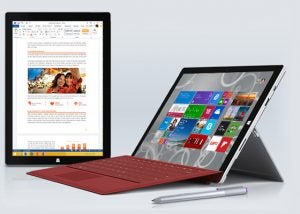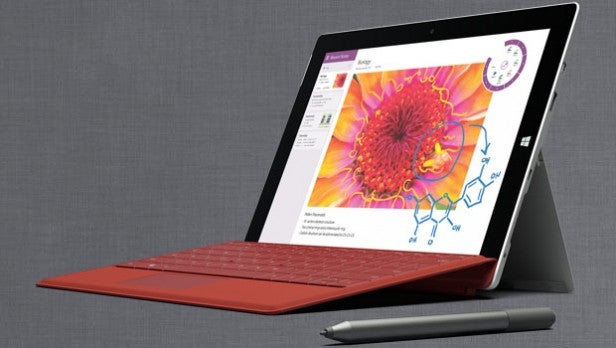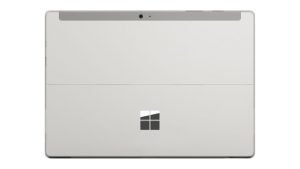Microsoft Surface 3 vs Surface Pro 3: What’s the difference?

Surface 3 or Surface Pro 3? We take a look at the differences in between the Microsoft tablet/laptop hybrids that almost share the same name
We’ve given our verdict on the Surface 3, the successor to the not so fantastic Surface 2 and it’s a big improvement. It’s also a cheaper alternative to the Surface Pro 3, arguably Microsoft’s best attempt at building a great tablet/laptop hybrid, so it’s worth considering.
So what separates the two portable, Microsoft machines other than that the word ‘Pro?’ We compare specs to see what.
SEE ALSO: Windows 10 technical preview first look
Same design, less flexible Kickstand
Where you’re unlikely to separate these two is in the looks department. Microsoft has kept to the same blueprint using the same magnesium alloy and ceramic finish. It’s no surprise that to find that the smaller Surface 3 is thinner and lighter as well.
Most notably, the Surface 3 weighs in at 622g, while the Surface Pro 3 weighs 800g. That’s what all those fancy components with their extra cooling will get you.
Both devices have an integrated kickstand, however the one on the Surface 3 doesn’t offer the same versatility as the Surface Pro 3 (pictured above), letting you only use it in three positions.
SEE ALSO: Windows 10 Mobile technical preview first look
Both run on full Windows
With Windows RT firmly on the scrapheap, Microsoft has ditched the more restrictive version of its operating system, which runs on the Surface 2 for a full-fat Windows 8.1 Pro. That means it matches the Surface Pro 3’s ability to run and install full desktop applications.
That means both will be upgradeable to Windows 10 when it launches later this year and for the Surface 3, it’s going to be free. The Surface 3 also comes with a one year free subscription to Office 365 Personal giving you access to the usual suspects like Word and Powerpoint.

The Surface 3 has a smaller screen, but same display technology
Where the Surface Pro 3 (pictured above) has a 12-inch screen, the new Surface 3 measures in with a 10.8-inch display but it does stick with the same ClearType HD display technology. It’s not the same exceptionally sharp 2,160 x 1,440 resolution, although the 1,920 x 1,280 HD should still deliver overall good viewing results.
Both tablets also come with the same, slightly unusual 3:2 aspect ratio. Previous Surface models went the 16:9 route, which was great for widescreen videos, but was pretty awkward when it came to using them as tablets in portrait view.
SEE ALSO: Surface Pro 3 vs MacBook Air
The Surface Pro 3 gives you more power
The Surface Pro 3 is a full on high-power laptop, packing a choice of fourth generation i3, i5, and i7 processors. These are no longer the latest Intel chips available for such devices, but they’re still highly capable.
The Surface 3’s quad-core Intel Atom x7-Z8700 might be what enables it to ditch the fatally flawed Windows RT, but it also ensures that it lags some way behind the Surface Pro 3 on performance.
While the Surface Pro 3 could conceivable run anything your desktop PC can manage (short of advanced gaming), the Surface 3 is really best suited to more general, less intensive tasks like word processing, web browsing, and media consumption.

Battery life is similar
Despite the considerable difference in power, as well as the Pro 3 having a larger, sharper display, battery life is actually pretty similar between these two tablet hybrids.
The more modest Surface 3 does, as expected, last a little longer than the Surface Pro 3 on a single charge. However, we’re only talking 10 hours versus 9 hours respectively.
We’d probably put that down to the physically larger battery of the Surface Pro 3 going some way to making up for its thirstier nature.

The Surface 3 is significantly cheaper
All of the superior specs of the Surface Pro 3 come at a higher cost, of course, though we wouldn’t call it expensive.
Microsoft’s premium tablet-laptop hybrid starts from £639 for the entry-level i3 64GB model. The mid-range model that most will opt for is the i5 128GB for £849. It stretches right up to the 512GB i7 model (which also doubles the RAM to 8GB) for £1,549.
Whatever the model, the Surface 3 is a fair amount cheaper. It starts from £419.99, which gets you the entry-level model with 64GB of storage and 2GB of RAM. You can double both if you’re willing to pay £499.99.
Only the Surface 3 comes with a 4G option
One notable advantage of the Surface 3 over the Surface Pro 3 is that it there will be a 4G LTE version introduced eventually (they’re listed as ‘Coming Soon’ on the Microsoft website).
This means that you’ll be able to connect your Windows 8.1 hybrid device to the internet even when you’re away from a Wi-Fi hotspot. All of which could make the Surface 3 the most compact tool there is for getting real work done on the move.


